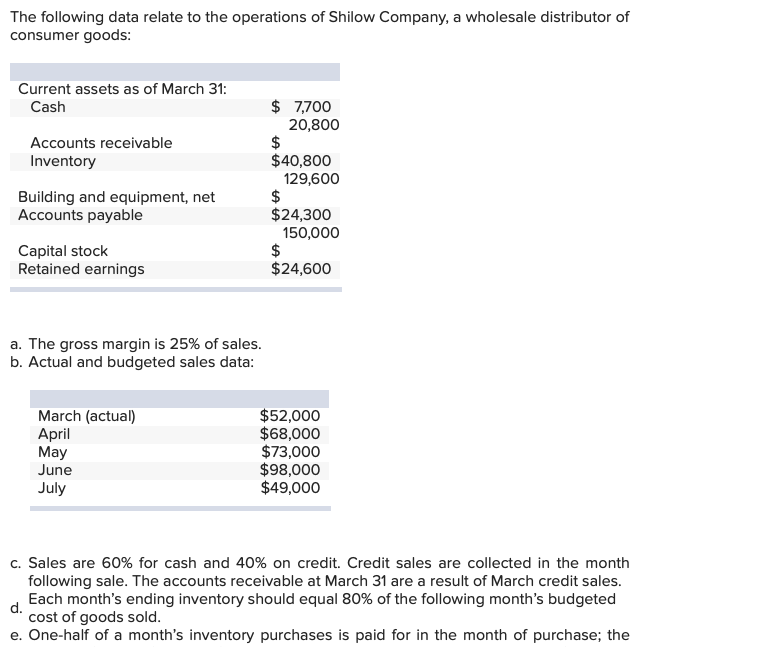



The following data relate to the operations of Shilow Company, a wholesale distributor of consumer goods: Current assets as of March 31: Cash $ 7,700 20,800 Accounts receivable Inventory $40.800 129,600 Building and equipment, net Accounts payable $24,300 150,000 Capital stock Retained earnings $24,600 a. The gross margin is 25% of sales. b. Actual and budgeted sales data: March (actual) April May $52,000 $68,000 $73,000 $98,000 $49,000 June July C. Sales are 60% for cash and 40% on credit. Credit sales are collected in the month following sale. The accounts receivable at March 31 are a result of March credit sales. Each month's ending inventory should equal 80% of the following month's budgeted cost of goods sold. e. One-half of a month's inventory purchases is paid for in the month of purchase; the other half is paid for in the following month. The accounts payable at March 31 are the result of March purchases of inventory. f. Monthly expenses are as follows: commissions, 12% of sales; rent, $2,500 per month; other expenses (excluding depreciation), 6% of sales. Assume that these expenses are paid monthly. Depreciation is $972 per month (includes depreciation on new assets). g. Equipment costing $1,700 will be purchased for cash in April. h. Management would like to maintain a minimum cash balance of at least $4,000 at the end of each month. The company has an agreement with a local bank that allows the company to borrow in increments of $1,000 at the beginning of each month, up to a total loan balance of $20,000. The interest rate on these loans is 1% per month and for simplicity we will assume that interest is not compounded. The company would, as far as it is able, repay the loan plus accumulated interest at the end of the quarter. Required: Using the data above: 1. Complete the following schedule. Quarter Schedule of Expected Cash Collections April May June Cash sales $ 40,800 Credit sales 20,800 Total collections $ 61,600 Check Figure: Total Cash Collections for Quarter $ 220,600 2. Complete the following: Quarter Merchandise Purchases Budget April May June Budgeted cost of goods sold $ 51,000 Add desired ending inventory 43,800 Total needs 94,800 Less beginning inventory 40,800 Required purchases $ 54,000 Check Figure: Total Merchandise Purchases for Quarter $ 167,850 Budgeted cost of goods sold for April = $68,000 sales * 75% = $51,000. Add desired ending inventory for April = $54,750 * 80% = $43,800. Schedule of Expected Cash Disbursements-Merchandise Purchases April May June Quarter March purchases $ 24,300 $ 24,300 April purchases 27,000 27,000 54,000 May purchases June purchases Total disbursements Check Figure: Total Quarterly Cash Disbursements for Merchandise $ 170,100 3. Complete the following cash budget: (Borrow and repay in increments of $1,000. Cash deficiency, repayments and interest should be indicated by a minus sign.) June Quarter Shilow Company Cash Budget April May 7,700 61,600 69,300 Beginning cash balance Add cash collections Total cash available Less cash disbursements: For inventory For expenses For equipment Total cash disbursements Excess (deficiency) of cash Financing: Borrowings Repayments Interest Total financing Ending cash balance Check Figure for April 51,300 14,740 1,700 67,740 1,560 $ 4,560 Check Figure for Quarter $ 5,770










